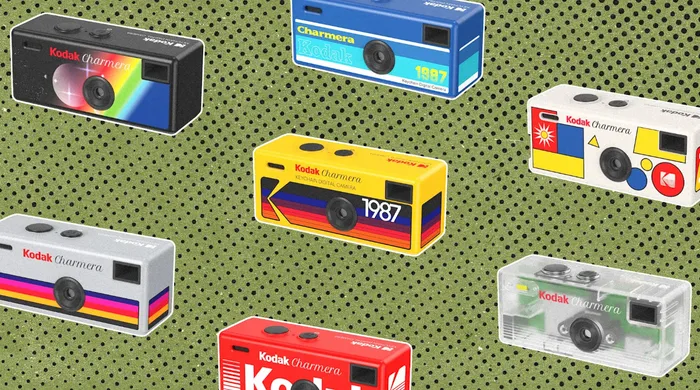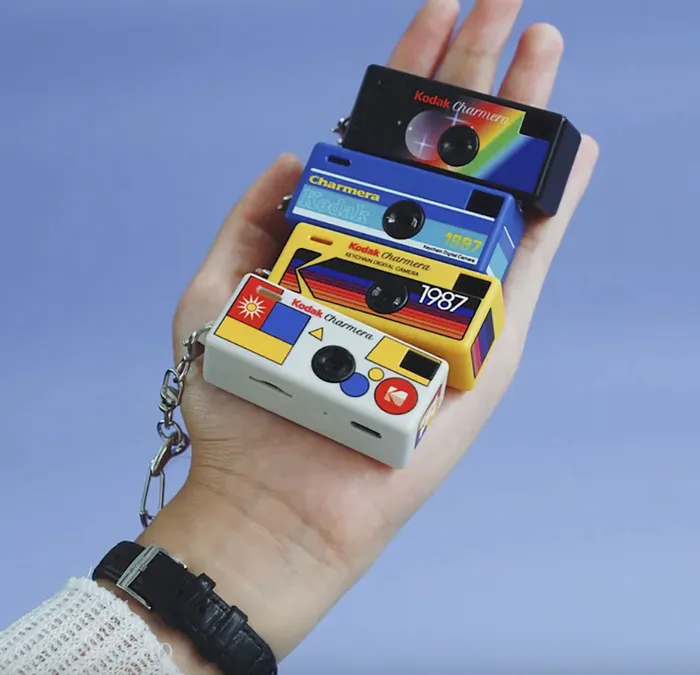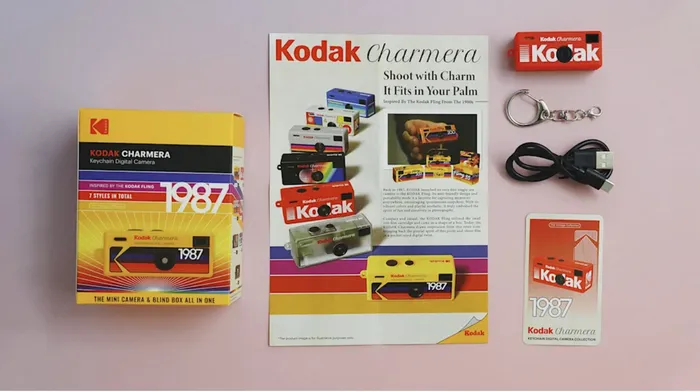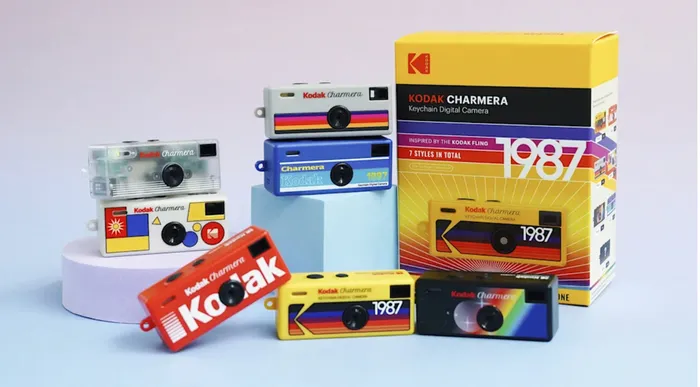
.
Image: Kodak; Plufow Le Studio/Unsplash
For a tiny device that clips onto your key ring, the Kodak Charmera makes an oversize impression. At least to me. The newest compact digital camera believes it is a 1980s Kodak Fling disposable camera, which itself was like a 120 Ektachrome film box with a lens and a viewfinder. It looks the part so well that it feels like a portal to my childhood. I imagine it smells of my dad’s cigarettes, just by looking at it.
For most of the people from this century who are attempting to buy the Charmera, however, its design will be more than a way to quench the thirst for a faux past they never had. Kodak’s newest camera is a perfect remedy to partly overcome the phone ban in schools that is taking place all over the world—from California and Madrid to Beijing and Sydney. Kodak may have introduced what might be 2025’s best digital gadget for . . . you know, for kids.
With no screens, no internet, no apps, and no notification tsunamis, the Charmera only lets you point and shoot. You can review each shot in a postage-stamp-size 0.8-inch LCD on its back, sure, but not many people will be using the display for that. It’s simply too tiny to see any detail clearly.

.
Image: Kodak
This is, I believe, something positive for the user experience, too. If you have to wait a few hours to get your image on a screen big enough to appreciate its value, your Instagramming, TikTokking, and WhatsApping will logically get much better. Time makes you see things from a different perspective, trust me. Plus, no Dean Ed Rooney trying to spoil your Bueller time.
Inside its 2.3-by-1-by-0.8-inch box sits a 1/4-inch CMOS sensor recording 1.6 effective megapixels at 1440-by-1080 pixels, paired with a fixed-focus 35-millimeter f/2.4 plastic lens and a built-in flash unit.
The way you use it is by putting your eye to its optical viewfinder. The camera shoots JPEG photos and video at 30 frames per second, stores two still photos internally (I was hoping for 24, like the Fling), and accepts microSD cards from 1 GB to 128 GB for virtually unlimited shots. A 200 milliampere-hour (mAh) battery, charged via USB-C, powers the whole rig, and a key chain clip turns it into a bag charm.
Kodak leans even harder into nostalgia with date stamps, four vintage Kodak frames, and seven pixel-art filters. But the final twist that may turn this into a bestseller is the blind-box distribution. You buy the box without knowing which of its seven retro designs you will get (plus a transparent secret edition that has 1 in 48 odds).
Each box sells for $30 per mystery box. You can also buy a six-pack guaranteed to include all standard designs (minus the secret design) for $180. No matter what, you will have to buy a lot more to get the transparent model.

.
Image: Kodak
The device can’t arrive at a better time. Despite wide usage among young people and kids, smartphones are increasingly being viewed as noxious, sometimes lethal devices for young people. Often, they are channels that throttle up bullying. Most of the time, they just suck your brain and make kids dumber (adults, too).
That’s why phones are vanishing from schools worldwide at a high pace. Florida banned them in classrooms in 2023, and by 2025, 35 states plus Washington, D.C., have restricted student phone use—more than a dozen imposing full “bell-to-bell” bans to curb plummeting test scores and mental health crises. New York’s statewide ban for 2025–26 and California’s 2026 mandate point to a broader crackdown.
Europe has pushed even further. Madrid barred personal digital devices for 550,000 preschool and primary students this year, imposing age-based screen limits from zero hours for toddlers to two hours weekly for 12-year-olds. That doesn’t mean phones are allowed then. Rather, it refers to two hours a week of screens like tablets for educational use. France piloted a “digital pause” in 180 middle schools before expanding nationwide in 2025. The Netherlands, Belgium, Italy, and Hungary enacted their own bans, and China, the earliest mover in 2021, tightened its rules again in 2023. This year, Chinese officials will further restrict screen and social media usage for kids to stop addiction and the increase of a common new dangerous syndrome that some doctors I know call “You are really getting so dumb with that phone of yours, Steve.”
Sure, there are helicopter parents worried about emergency access (even while they grew up with no cellphones themselves and apparently survived), but most normal people are happy about the expanding bans. I know that almost all my fellow school parents are ecstatic about it.
Many students don’t like it either, of course. (Greek students protested after 6,000 suspensions.) And experts warn that bans alone don’t solve social media addiction. But facts are hard to ignore: The United Nations Educational, Scientific, and Cultural Organisation (UNESCO) says that phones cost students 20 minutes of focus per distraction, reinforcing policymakers’ resolve. The stats also tie increasing phone usage to an increase in bullying. (And vice versa: This study shows that banning phones decreased bullying).
I’m sure that some will be able to find nefarious usages for the Kodak Charmera. Or some kids will get obsessed with retro photography. But it sure beats the alternative.

.
Image: Kodak
The Charmera is already sold out everywhere. Maybe Reto Production Ltd.—the global licensee for the Kodak brand, responsible for the Charmera and other retro camera models—has limited access on purpose to make it a coveted product in the social sphere. Perhaps they couldn’t anticipate such a strong appetite for a tiny, attractive way to capture images anywhere without a cellphone. I asked the company, but it did not respond.
It doesn’t really matter. At $30, it is the perfect stocking filler. My Spidey sense tells me that it may end up being the hottest thingamajig you will try to buy this holiday season.
ABOUT THE AUTHOR
Jesus Diaz is a screenwriter and producer whose latest work includes the mini-documentary series Control Z: The Future to Undo, the futurist daily Novaceno, and the book The Secrets of Lego House.
